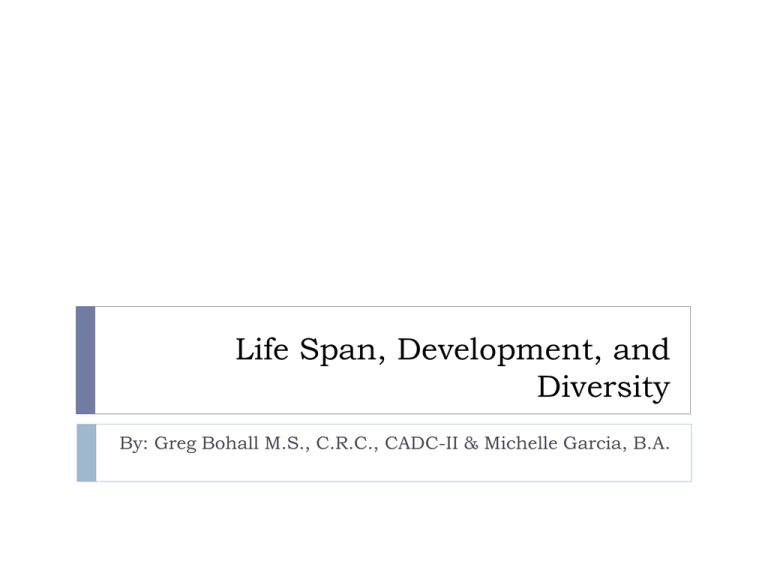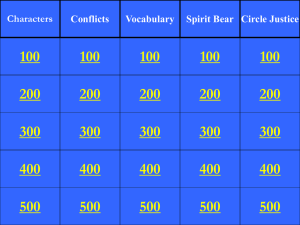
Life Span, Development, and
Diversity
By: Greg Bohall M.S., C.R.C., CADC-II & Michelle Garcia, B.A.
The Classic Debate…
Nature vs. Nurture
Nature/genetic factors
Nurture/environmental factors
Extent to which individual differences in complex traits in a
population are due to genetic factors. Ex: Intelligence and Personality.
Extent to which the environment plays a role in our development.
Ex: Athletic ability
Discussion: Does athletic ability have nature or nurture
factors?
(Berk, 2007)
The Classic Debate (continued)…
Many investigators believe that nature and nurture are
inseparable and work together.
Genetic-Environmental Correlation: our genes influence
the environments to which we are exposed.
Passive: Child has no control and parents provide
environments influenced by their own heredity.
Ex: Athletic parents emphasizing outdoor activities, swimming, etc.
Evocative: Children evoke responses that are influenced by the
child’s heredity and the responses strengthen the child’s
original style.
Ex: Active, friendly baby more likely to receive attention than a passive,
quiet infant.
(Berk, 2007)
The Classic Debate (continued)…
Active: As children extend their experiences beyond the
immediate family, freedom increases, and they actively seek new
environments.
Niche-picking: the tendency to actively choose
environments that are complementing our heredity.
Famous niche-pickers
Laila Ali (Muhammad Ali)
Jaden Smith (Will Smith)
George Bush Jr. (George Bush Sr.)
Liv Tyler (Steven Tyler)
(Berk, 2007)
Erikson’s Psychosocial Theory of
Development
At each stage, there is a basic psychological conflict which
is resolved along a continuum from positive to negative,
which determines healthy or maladaptive outcomes at
each stage.
“Normal” development must be understood in relation
to each culture’s life situation.
(Berk, 2007)
Erikson-Infancy
Stage 1: Basic Trust vs. Mistrust (Birth-1 year)
Takes place during infancy.
When care is generally sympathetic and loving, the
psychological conflict is generally on the positive trust side.
The trusting infant expects the world to be good and is
confident in venturing out and exploring.
The mistrustful baby cannot count on kindness and
compassion from others so they withdraw from people.
(Berk, 2007)
Erikson-Toddlerhood
Stage II: Autonomy vs. Shame and Doubt (1-3 years)
When parents provide young children with suitable guidance
and reasonable choices, this stage is resolved favorably.
A self-confident, secure 2-year-old has been encouraged (eating
and toilet training) and not criticized or attacked when failing
at new skills.
An over or under controlling parent is likely to be in other
aspects of the toddler’s life as well therefore the child feels
forced or shamed and doubts their ability to act competently
on their own.
(Berk, 2007)
Erikson-Early Childhood
Stage III: Initiative vs. Guilt (3-6 years)
Children begin to initiate their own activities and feel
accomplished and become purposeful.
If child is not allowed or punished for their own initiative they
will develop a sense of guilt in their attempts of being
independent.
If parents encourage this initiative, the child’s exploration will
lead to the identification of activities with peers and
discoveries.
(Berk, 2007)
Erikson-Late Childhood
Stage IV: Industry vs. Inferiority
Children learn to develop knowledge and success at activities
their parent or guardian values
If child does not develop the knowledge and success they feel
inferior
A child who is unsuccessful of his father’s favorite sport,
football, may feel inferior to his brother who is one of the
better players on their team
(Cole, Cole, & Lightfoot, 2005)
Erikson-Adolescence
Stage V: Identity vs. Role Confusion (Adolescence)
Identity is a major personality achievement of adolescence and
is a crucial step towards becoming a productive and happy
adult (Berk, 2007).
Adolescents begin to develop an identity as part of their social
group(s) (Cole, Cole, & Lightfoot, 2005).
Adolescents who are unable to identify themselves may have
confusion towards who they are or what they want to do in
life (Cole et. al., 2005).
(Berk, 2007; Cole, Cole, & Lightfoot, 2005)
Erikson-Early Adulthood
Stage VI: Intimacy vs. Isolation (Early Adulthood)
The person’s thoughts and feelings about making a permanent
commitment to an intimate partner (Berk, 2007)
Young adults begin to develop intimate relationships (Cole,
Cole, & Lightfoot, 2005).
For those who have an absence of these relationships, they feel
that they are at risk of loneliness or isolation (Cole et. al.,
2005).
(Berk, 2007; Cole, Cole, & Lightfoot, 2005)
Erikson-Middle Adulthood
Stage VII: Generativity vs. Stagnation (Middle Adulthood)
Adult wants to feel productive in their work and start creating a
family (Cole, Cole, & Lightfoot, 2005).
Generativity involves reaching out to others in ways to guide the
next generation (Berk, 2007).
Stagnation involves the person becoming self-centered or selfindulgent due to attaining certain life goals (marriage, children,
career success, etc.) (Berk, 2007).
Adults who are unsuccessful or unhappy with their job and/ or
performance they feel a sense of stagnation (Cole et. al., 2005).
Adults who have not started creating their family also feel
stagnation (Cole et. al., 2005).
(Berk, 2007; Cole, Cole, & Lightfoot, 2005)
Erikson-Late Adulthood
Stage VIII: Ego Integrity vs. Despair (Late Adulthood)
Older adults begin reflecting on their past experiences to
determine whether they have lead a meaningful life (Cole,
Cole, & Lightfoot, 2005).
Adults who have the sense of integrity feel whole, complete,
and satisfied with their achievements (Berk, 2007).
Those who have unachieved goals, regrets or ill-spent lives
despair on their past experiences and life (Cole et. al., 2005).
(Berk, 2007, Cole, Cole, & Lightfoot, 2005)
Vygotsky’s Sociocultural Theory
Addresses the cultural context of people’s lives.
The sociocultural theory focuses on how culture is
transmitted to the next generation.
Culture: values, beliefs, customs, and skills of a social group.
Social interaction is necessary for children to acquire the
ways of thinking and behaving that make up the culture of
the community.
The belief that adults are more expert peers to help
children master culturally meaningful activities.
(Berk, 2007)
Vygotsky’s Sociocultural Theory (con’t)
Zone of Proximal Development
Began examining the impact of the parent-child interaction.
Zone: gap between what a child can accomplish independently
versus what a child can accomplish when they are assisted by
another who is competent in the activity.
Proximal: “nearby”, the assistance that is provided should be
slightly above the child’s current competency level.
(Cole, Cole, & Lightfoot, 2005)
Freud-Psychosexual Theory
Oral: First year Mouth is focus of pleasurable sensation
(sucking).
Anal: Second year Anus if focus of pleasurable sensations
(elimination).
Phallic: 3-6 years Develop sexual curiosity and obtain
gratification when they masturbate (sexual fantasies about
parent or opposite sex, feel guilt about fantasies).
Latency: 7-adolescence Sexual urges are submerged and focus
is placed on mastering skills valued by adults (“cooties”,
sports).
Genital: Adolescence Have adult sexual desires and seek to
satisfy them (“truth or dare”).
(Cole, Cole, & Lightfoot)
Diversity- Some definitions
Ethnicity: categories of people who are distinctive on the
basis of national origin (German, Italian, etc.).
Race: categories that encompass different ethnic groups.
Ethnicity attempts to capture people’s actual practices
White race: Italian, Irish, Swedish
Focusing only on race hides important differences
Sex: refers to males and females (chromosomal,
anatomical, hormonal, physiological).
Gender: socially constructed models associated with each
sex.
(Rosenblum & Travis, 2012)
Diversity-Some definitions (con’t)
Sexual Orientation: directionality of one’s sexual interests
toward members of the same sex, the other sex, or both
(Rathus, Nevid, & Fichner-Rathus, 2011).
Social class: seldomly discussed so definition is not well
developed. We almost never speak of ourselves in society
in class terms as it is not a central category in America
(Rosenblum & Travis, 2012).
What are some other diversity areas?
(Rathus, Nevid, & Fichner-Rathus, 2011, Rosenblum & Travis, 2012)
References
Berk, L. E. (2007). Development through the lifespan (4th Ed.)
Allyn and Bacon: Boston, MA.
Cole, M., Cole, S. R., & Lightfoot, C. (2005). In the beginning. The
Development of Children (5th Ed.). Worth Publishers: New York,
NY. Pp. 45-112.
Cole, M., Cole, S. R., & Lightfoot, C. (2005). Infancy The
Development of Children (5th Ed.). Worth Publishers: New York,
NY. Pp. 113-278.
Rathus, S. A., Nevid, J. S., & Fichner-Rathus, L. (2011). Human
sexuality in a world of diversity (8th Ed.. Allyn and Bacon:
Boston, MA.
Rosenblum, K. E. & Travis, T. C. (2012). The meaning of difference (6th
Ed.). McGraw Hill: New York, NY.









